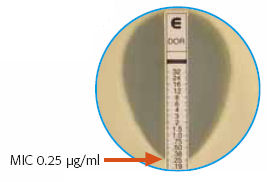An ongoing dialogue on HIV/AIDS, infectious diseases,
June 12th, 2012
ID Learning Unit — The Etest
 Every year I attend on the general medical service, so it gives me a chance to work directly with the medical residents — and to brush up on my non-ID-related Internal Medicine.
Every year I attend on the general medical service, so it gives me a chance to work directly with the medical residents — and to brush up on my non-ID-related Internal Medicine.
In exchange for what they teach me, each day on rounds I try to tell them about at least one ID-related thing that they may not know. Since I do this in the spring, they’re awfully sharp. Fortunately, I’ve been doing this ID stuff a long time, so can usually find something.
Today’s learning unit was the “Epsilometer Test, or “Etest” — that brilliantly simple way of estimating the MIC of an antibiotic to an organism, by using a drug-impregnated strip that has a gradient of concentration, from high to low. Find where the “elipse” of inhibition crosses the strip, and presto! There’s your MIC.
We take for granted that this method is readily available and, for the most part, clinically valid. It’s worth remembering, however, that when it debuted in the late 1980s/early 1990s, it was considered pretty slick and not entirely trustworthy.
And there’s still some debate about how reliable it is, especially with MRSA.
If you want to learn how to do it, watch this movie.


Thank you for producing Etest video. In early years of my internal medicine practice I performed simple office bacteriology using commercial blood agar plates and a simple incubator. At times, I would take home the day’s throat cultures (before availability of rapid identification tests) and leave them in our gas oven overnight (pilot light always on in the era of endless energy availability) for reading early the next morning. I love simple bacteriology and believe house officers and students should still perform these tests in special ward laboratories. Of course, this is heresy today. Places to Gram stain a specimen and view with a microscope are not available on the wards of most teaching hospitals (where is the closest microscope on your teaching service?)
EW
Amen! I have had the same experience in my years of practice: as a house officer, REQUIRED to do our own bacteriology on patient sputum and urine. In practice, gram stains were part of the day with microscope at hand. Throat cultures on blood agar done in the office. Microscopes part of practice until 2002. Now less and less. This is a great loss for those still in training.